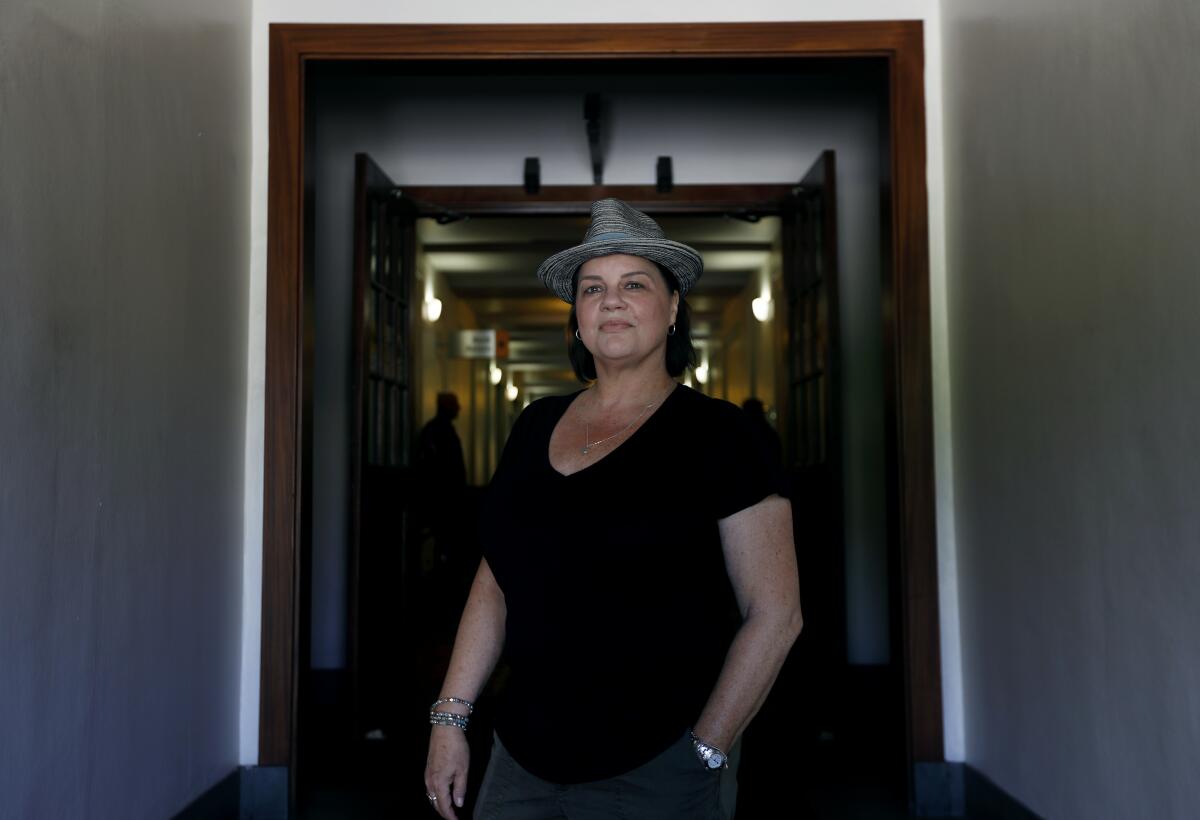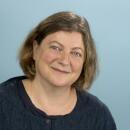Column: When cancer closed in, a photographer turned to Los Angeles to help see her through
- Share via
When you face the reality that you may not be long for this world, what you encounter every day can start to look new, intensely in focus.
A stranger confidently striding down a sidewalk, jacaranda blossoms strewn around a sprinkler head on dry, cracked earth — things that you always saw but never stopped to look at can read like signs and split you wide open.
Los Angeles is home for photographer Cat Gwynn, born in Glendale like her mother before her. She’s inhaled and exhaled L.A. all her life. But in the months after she woke one morning and felt a lump in her right breast, she began to experience her city in a heightened way, and to call on it to help pull her through.

A sliver of Gwynn’s story flickered across my screen this week — an announcement of a talk she would be giving the next day. I’d never heard of her, but it was enough for me to drop everything and go.
I wasn’t alone. Though the gathering in the Central Library’s Meeting Room A was not large, it felt — especially when people approached her after she spoke — like a huddle of moths drawn to a lamp. Some who followed Gwynn on social media had come to hear more about how, in her darkest moments, she had found light on the streets of L.A.
Among them were fellow cancer survivors, photographers, a man who said he had been in and out of hospice three times and knew that feeling of seeing as if for the last time.
“There was so much magic in every day,” Gwynn told them of the way she captured her city at a time when all certainty had been swept out from under her.
Nine years before Gwynn felt the lump, her mother had died of breast cancer. Now here she was in the spring of 2013, diagnosed with the same disease, in a rarer form known as triple negative that can be hard to treat.
Very soon, she was being clobbered by such a toxic cocktail of chemotherapy drugs that the nurses who administered it wore hazmat gear. Two different kinds of chemo, surgery, 33 rounds of radiation — what was working to stem the disease also was shrinking her life.
Her immune system was compromised. She couldn’t travel far from home. The way she felt limited how much work she could take on. The treatments kept her tautly tethered in what she began to call her 10-mile radius.
And even though she had practiced mindfulness and meditated for years, Gwynn knew she now needed to do more than sit on a cushion, alone with her thoughts.
And so she started walking — and when it came time for radiation, though her doctors were at Cedars-Sinai she chose to go to Hollywood Presbyterian Medical Center on foot.
As she walked out from her Los Feliz apartment, she found beauty in the just barely visible. The red-paper liner of a cupcake splayed flat on a gray street surface. A rainbow of balloons, clustered like grapes, hovering just above the roof of a party supply store. A woman standing in the rain across from a Ralphs, under an umbrella dotted with hearts.
Before her illness, she had been immersed in portraiture, working on a series of photos of men crying. She also does commercial work. She was used to Nikons.
Now she was traveling light, without her professional equipment. On her iPhone, she began collecting tiny L.A. moments as talismans. Each one formed a part of her daily incantation to be present and open to all that came her way, however difficult.
What she was doing was a sort of anchoring in rough seas, with the city she loved providing safe harbor. “I decided to seek out and capture images every day that would connect me to life — a gratitude practice in motion. ... ,” she would later write. “I attuned to the immediacy of each day and found my purpose.”
At night, when steroids meant to ease the side effects of chemo popped her awake at strange hours, she looked through the images and used photo editing apps to turn some into “little jewels” that conveyed exactly how they made her feel. It was a ritual, she said, that calmed her and helped her process her emotions.
She scattered her new work on social media, without sharing her story. Still, people who knew nothing about her responded to their potency.
“I was sitting in this tension between life and death and not knowing,” she told the library group of that time.
Later she would collect the photographs into a book, “10-Mile Radius: Reframing Life on the Path Through Cancer,” and make their titles markers on her journey. The quavering reflection of a motel’s neon sign on the twilight surface of its swimming pool: “Vacancy.” The jacaranda blossoms on dirt: “Drought.” The evidence of a cupcake eaten: “Remnant of Momentary Pleasure.”
The torn screen in a screen door in front of a closed red door with a silver lock: “Ripped Open.” (The first time I saw that one, tears.)
The floating rainbow of balloons, a lift she so needed, she named “Breathe.” And that umbrella of hearts? It spoke to her of her friends — so it became “Showered With Love.”
Interspersed with the images are Gwynn’s telling of her story as well as words she found strengthening from others. From a poem by Mascha Kaléko: “When the waves close over me, I dive down to fish for pearls.”
From Gwynn: “Love saturates the world. I found the simplest expressions of it in the damnedest places. Hidden in shadows patiently waiting to be revealed. In plain sight, brilliant in its familiarity. Shining through cracks and crevices, exposing hope and compassion.”
Other people found their way into her focus, too. During her walks to and from radiation, she kept noticing faces. She thought about the need for contact and how some avoid it, maybe to keep from knowing and carrying the weight of others’ burdens.
One day, she saw a big, tough-looking guy with “Los Angeles” tattooed in thick, Gothic letters on the back of his bald head. When she asked if she could take his picture, he did not appear enthused. Then she took off her hat, showed him her own baldness and he nodded his assent.
She followed him as he stepped into a building’s subterranean entrance. At first, she thought she’d lost all chance for a good shot. Then she saw the ceiling beams above, fanning out like rays of light. From that day on, on each day of treatment, she made this her portrait-taking spot.
It was a medical building, she told the audience at her library talk. Most of the people she photographed had their own health struggles. She felt their empathy for her. She offered them hers. They became her angels in a city that was named for them.
Six years have passed since that diagnosis. Gwynn is 57 now. She’s cleared big hurdles but may still face more. What has helped her keep steady, she has tried to teach others.
When a friend who has Parkinson’s disease asked her to show him what she had been doing, they began an ongoing series of photo safaris to different parts of town — in which they first meditate and then wander off, meeting up to eat together and share images of the details that spoke to them. They joke about these adventures of Baldy and Shaky, though Gwynn’s hair has grown back.
She recently told her story at a symposium at Harvard Medical School. And at the library, she told her audience that it is unfinished.
When I first reached out to her the day before her talk, she was at Cedars for a new round of tests. Her latest checkup had raised some concerns. She was awaiting the last batch of results. For her, that may always be true.
Meanwhile, she continues to find sustenance in her city and to say to herself, as she said to me, “What if I put my mind towards a story of being alive at this moment?”
More to Read
Sign up for Essential California
The most important California stories and recommendations in your inbox every morning.
You may occasionally receive promotional content from the Los Angeles Times.











